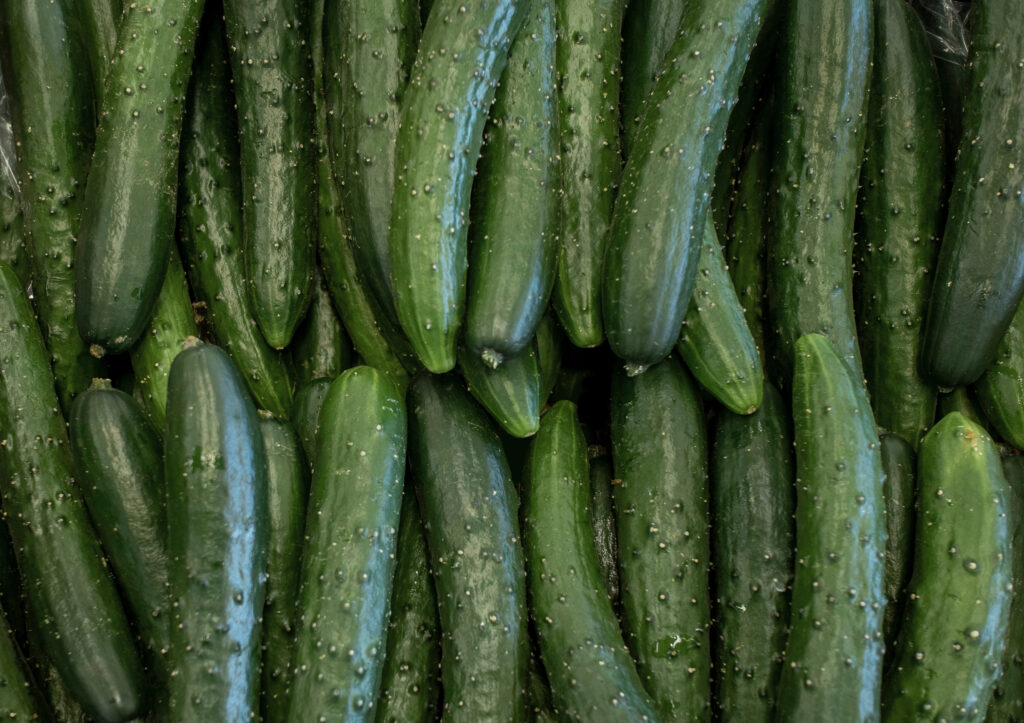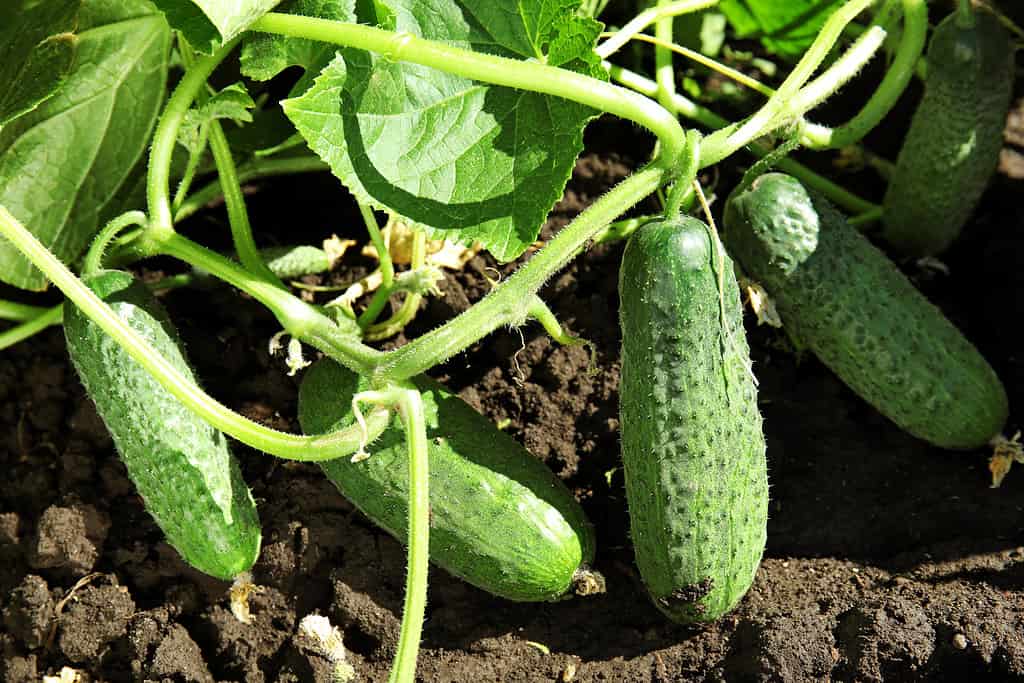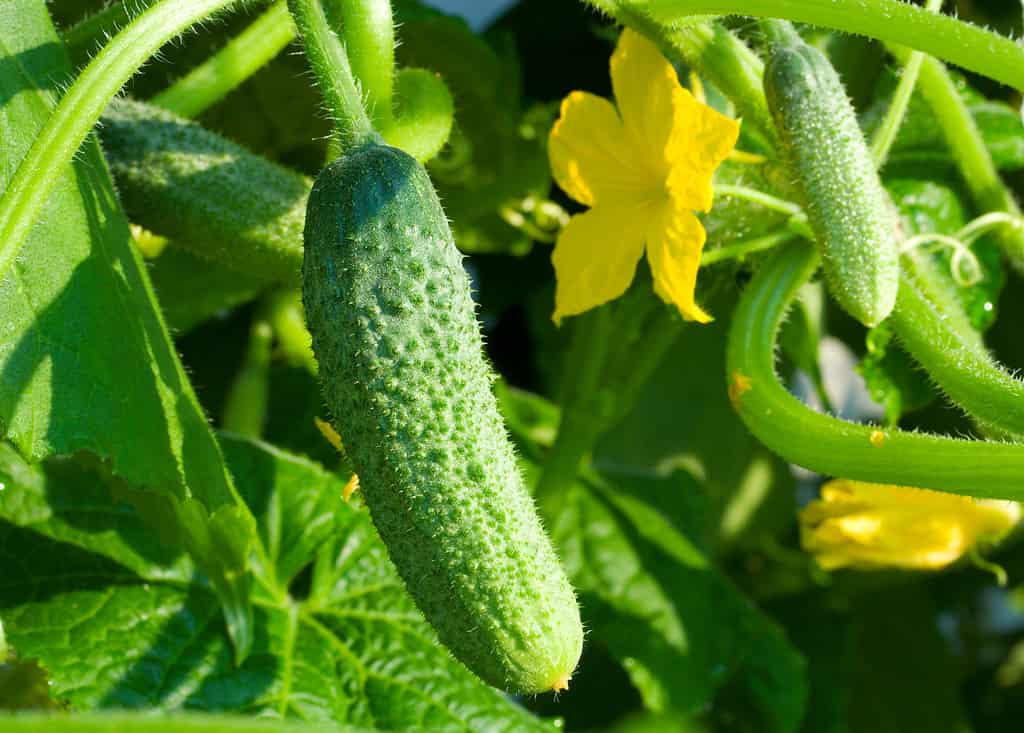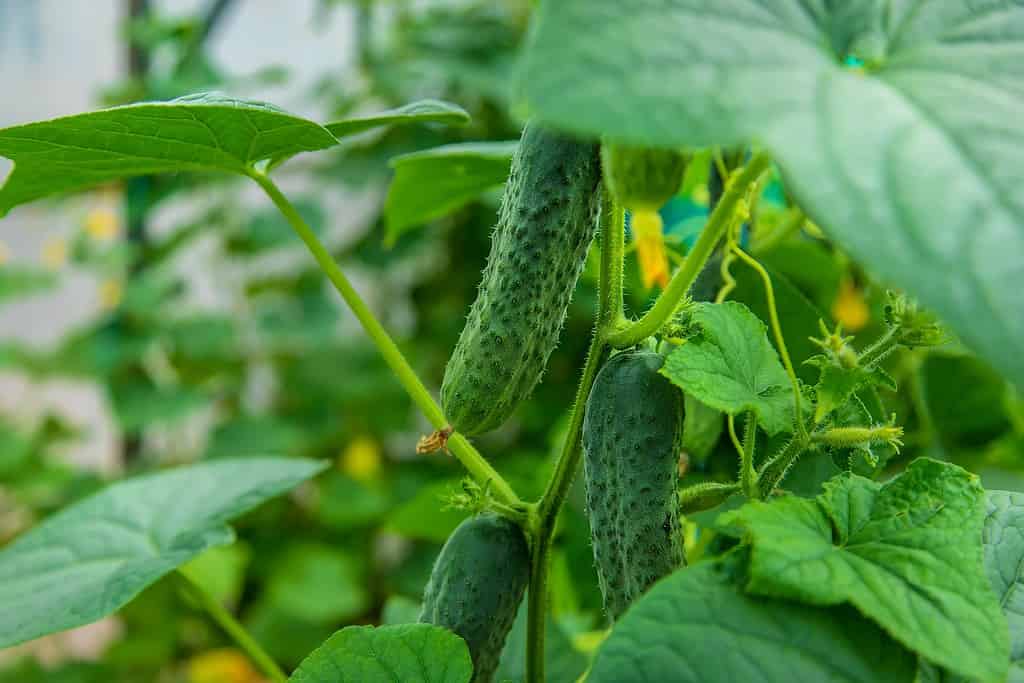Growing cucumbers is a simple task that requires plenty of sun and water. Be sure to pick the cucumbers before they get too big, or their taste will become bitter. Enjoy the deliciousness of these vegetables when you’ve grown them yourself! Planting and harvesting cucumbers from your own garden is a straightforward process. Here is our complete guide to get you started.
About Cucumbers

Bush cucumbers are ideal for containers and small gardens.
©loveshiba/Shutterstock.com
Two types of cucumber plants exist – vining and bush. Vining cucumbers are the most common and grow quickly with large leaves if taken care of properly. They are best when trained up a trellis or fence, as the fruits will be cleaner, more abundant, and easier to pick. Bush cucumbers, on the other hand, are ideal for containers and small gardens.
If you’re interested in making pickles, you should try growing some of the varieties that are specifically bred for pickling, like heirloom varieties’ Boston Pickling’ or ‘Calypso.’ To ensure the pickles are crunchy, make sure to process them shortly after you harvest them!
Where to Plant
When selecting the site to plant your cucumbers, be sure it gets at least 6-8 hours of direct sunlight daily. Cucumbers like warmth and light! When preparing the soil for planting, ensure that it is fertile – add about 2 inches of aged manure or compost to the bed and work it into a depth of eight inches.
The ideal pH level should be around 6.5-7.0, so make sure to test the soil by contacting your local county co-op extension if you are unsure about your particular soil type. You can also buy simple pH test kits at garden centers. If you have clay soil, adding soil amendments will help improve it. Dense, heavy soils benefit from adding leaf mold, rotted manure, and compost. Gardens with lighter sandy soils warm up quickly during spring, which makes them an ideal location for growing cucumbers successfully!
When to Plant
If you plan to plant your cucumber seeds indoors, ensure the temperature is about 70ºF. You can use a heating pad for this purpose or place the seed flats on top of an appliance such as a refrigerator or water heater that produces heat. This will give them enough time to germinate and become ready for transplanting outdoors when the last frost has passed. It’s important not to rush this process, as starting too early might cause your cucumbers to be stunted in growth due to cold temperatures outside.
When planting cucumbers outdoors, wait at least two weeks after the last frost date. Cucumbers are very sensitive to cold temperatures, and any exposure to frost or cool weather can harm them. The soil temperature should be 70ºF for germination and transplanting seedlings. This ensures that they will take root properly and grow healthy. If you live in a cooler climate, warm up the soil before planting by covering it with black plastic. This will help keep the soil temperature consistent so that your cucumber plants can thrive!
Remember to make continual plantings every two or three weeks in order to have a continuous harvest. Planting at regular intervals helps ensure that you can enjoy your cucumbers throughout the growing season. It also allows you to stagger the maturity of your plants so that one variety may be ready for harvest before another has even begun producing fruit. Depending on the variety and weather conditions, you can plan on harvesting your cucumber crop about 50-70 days after planting.
How to Plant

Cucumber seeds should be sown 1 inch deep and spaced 3 feet apart in a row.
©New Africa/Shutterstock.com
When planting cucumbers, take into account the type of variety you are growing, as spacing requirements may vary. Generally, however, seeds should be sown 1 inch deep and spaced 3 feet apart in a row. If you plan on training your vines onto a trellis, space out plants or seeds 1 foot apart instead. An alternate way of planting cucumbers is by using soil hills, which should be spaced 12 inches apart, with three seeds per hill. When plants reach three or four inches in height, thin them down so that only one plant remains per mound for optimal growth and production.
In addition to covering the hill or row with black plastic to warm the soil prior to planting, it is also a good idea to mulch around the area with straw or another organic mulch. Doing this helps keep pests away from your cucumbers and keeps bush types off the ground, which can help avoid disease. Mulching will also help conserve moisture in between waterings and regulate soil temperature fluctuations throughout the day. For best results, choose a type of mulch that can hold up against rain and windy conditions, such as wood chips or pine needles. Make sure you cover an area at least two feet by two feet for each hill or row of cucumber plants so that they have plenty of room spread out their roots.
When planting cucumber seeds, a trellis can be a great option for those that have limited space. It provides the vine with something to climb up and prevents damage from occurring to the fruit if it is sitting on wet ground. Additionally, in order to prevent pests from digging out or eating the newly planted seeds, you can cover them with netting or milk jugs. This will protect your plants until they have sprouted.
How to Grow
It is important to ensure that cucumbers receive consistent water throughout the growing season. Watering frequency should increase as seedlings emerge. Seedlings should be given at least one inch of water per week (or more if temperatures are higher). It is best to water in the morning or early afternoon and avoid getting the leaves wet, as this can lead to fungal diseases which could damage the plant. To keep foliage dry, use a soaker hose or drip irrigation system when possible for watering your cucumbers. Inconsistent watering can also result in bitter-tasting fruit, so it’s important to stick with a regular schedule for optimum yield!
Mulch is an important component of a successful cucumber crop. It helps retain soil moisture so that the plants don’t dry out too quickly and helps prevent weeds from sprouting up in between your cucumbers. A thick layer of mulch around each plant should help maximize its growth potential!
If you start noticing pests around your plants, such as aphids or beetles, cover them with netting to keep them away. When the seedlings reach 4 inches tall, thin out the plants so that they are 18 inches apart. This will give each plant more space for nutrients and water and reduce competition among the cucumbers themselves.
If you have a small area or want your cucumbers to climb vertically, set up a trellis early to avoid harming the seedlings and vines. To feed the plants, use a liquid form of 5-10-10 fertilizer one week after the plant starts blooming and every three weeks after that. Incorporate granular fertilizer into the soil as well, but be careful not to over-fertilize, or the cucumbers will be stunted or burned.
When to Harvest

Cucumbers are best picked before their seeds become hard, as they will have a better flavor when immature.
©Andrey Shtanko/Shutterstock.com
When cucumbers are ready to harvest, you should check your plants every few days and pick any ripe fruit. It’s important not to let the cucumbers grow too large before harvesting them, as this will make them taste bitter. The ideal size for a cucumber is 7-8 inches long. Anything larger than that will likely have an unpleasant flavor, so it’s best to harvest early if possible. Additionally, regularly removing fruits from your plant allows more room for new growth, which means more produce!
It is important to know when to harvest cucumbers in order to ensure the highest quality and flavor. Salad or slicing cucumbers should be harvested when they are less than eight inches long, dill varieties when they are less than six inches long, and pickling cucumbers at around two inches long. The large burpless variety can get up to 10 inches in length or even larger, depending on the type.
Cucumbers are best picked before their seeds become hard, as they will have a better flavor when immature. Do not wait until they turn yellow, as this indicates that they have been left on the vine too long, resulting in tough skins and decreased plant productivity.
How to Harvest
When harvesting cucumbers, be sure to use a knife or clippers to cut the fruit from the plant. Pulling it off may damage the vine and reduce its potential for future growth.
Once you have started harvesting, keep going! If you don’t continue to pick your cucumbers as they mature, the plants will eventually stop producing new ones. It’s important to remove all of your cucumbers so that more can grow in their place and provide you with an ongoing supply of produce throughout the season.
How to Store
To store cucumbers, wrap them tightly in plastic wrap to retain as much moisture as possible. Cucumbers are over 90 percent water; this wrapping step helps prevent dehydration. When stored correctly, cucumbers will keep for 7 to 10 days in the refrigerator.
Pickling cucumbers is a great way to store them and also an excellent way to preserve the flavor and nutrition of your harvest. Use fresh cucumbers for pickling; those that are overripe will produce mushy pickles. Pickled cucumbers can be stored in an airtight container in your refrigerator for up to three months, so enjoy them all summer long!
Easy Refrigerator Pickle Recipe
- 1.5 cups white vinegar
- 3 Tablespoons kosher salt
- 2 Tablespoons white sugar
- 2 pounds cucumbers, cut into spears
- 2 Tablespoons coriander seeds
- 1 teaspoon mustard seeds
- 16 sprigs of fresh dill
Instructions: In a small saucepan, heat white vinegar, salt, and sugar until well dissolved. Divide the cucumbers into two 1 quart glass jars. Divide the coriander, mustard, and dill between the two jars. Pour the brine into the jars to cover the cucumbers. Store in the refrigerator for 1-3 months (if they last that long). You can also add garlic cloves or red pepper flakes if you like them a bit spicy.
Companion Plants

When harvesting cucumbers, be sure to use a knife or clippers to cut the fruit from the plant. Pulling it off may damage the vine and reduce its potential for future growth.
©Tatevosian Yana/Shutterstock.com
Ideal companion plants for cucumbers are corn, dill, peas, green beans, marigolds, nasturtiums, root vegetables, and sunflowers.
Corn. If you are growing a type of cucumber that is not too heavy, like pickling cucumbers, you can save space by using corn stalks as trellises. The cucumbers will provide natural mulch beneath the stalks, helping to retain moisture and stop weeds from growing.
Dill. Dill is an excellent choice to plant in a home garden because it can attract helpful bugs such as pollinators and parasitic wasps, which will help your cucumbers to grow and keep other garden pests away. Additionally, some gardeners believe that it can even improve the taste of mature cucumbers. However, it is important to be cautious with other strong-smelling herbs, such as mint, as their strong scents and flavors may have an impact on the flavor of your cucumbers.
Legumes. Legume plants such as green beans and peas are a great option to plant alongside cucumbers as they fix nitrogen into the soil to feed your cucumber vines.
Marigolds. Marigolds are a highly favored plant to have near cucumbers due to the fact that they can keep a wide range of pests away, like the aphids that often target cucumber foliage.
Nasturtiums. Pretty flowers, known as nasturtiums, can be planted near a vegetable garden to draw aphids away from the crops. This may seem like an odd choice. However, many gardeners do this in order to protect their vegetables by providing insects with something else to snack on instead.
Root vegetables. Cucumber plants have a single, deep taproot, and the rest of their roots are much smaller and more shallow. This makes cucumbers an ideal companion to root vegetables since they won’t compete for space under the soil. Additionally, planting radishes near cucumbers may help to keep away cucumber beetles, the most common enemy of cucumber patches.
Sunflowers. A method to save room and get the most out of your garden is to use sunflower stalks for cucumbers to climb instead of corn stalks. Just make sure you’re using a small cucumber variety or picking them when they are still very small so that the sunflowers are able to support them.
Summary of How to Grow Cucumbers
| Growing Cucumbers | Cucumber Recommendations |
|---|---|
| Sun | Full sun. 6-8 hours of direct sunlight per day. |
| Soil | Fertile soil with a pH of 6.5 to 7.0, dug to loosen up at least eight inches. |
| When to Plant | When the soil temperature is 70°F. |
| Planting Measurements | 1 inch deep, 12 inches apart. Rows 3 feet apart. |
| When to Harvest | Harvest in 50-70 days, and pick continuously until frost. |
| Storage | 7-10 days in the fridge wrapped in plastic. Pickles last for three months or more. |
| Companion Plants | Corn, dill, peas, green beans, marigolds, nasturtiums, root vegetables, and sunflowers. |
The photo featured at the top of this post is © loveshiba/Shutterstock.com
Thank you for reading! Have some feedback for us? Contact the AZ Animals editorial team.






